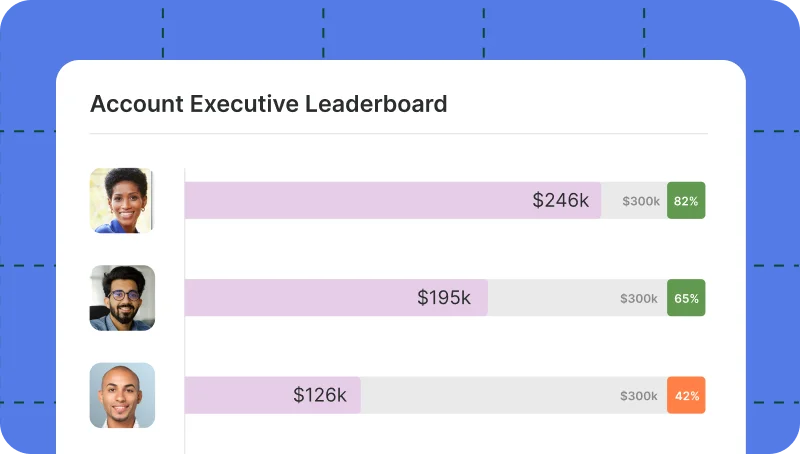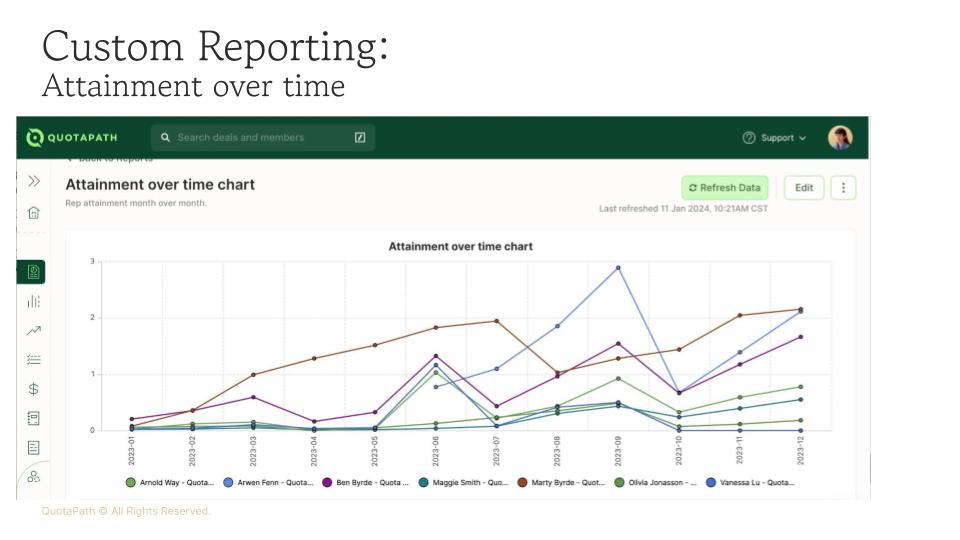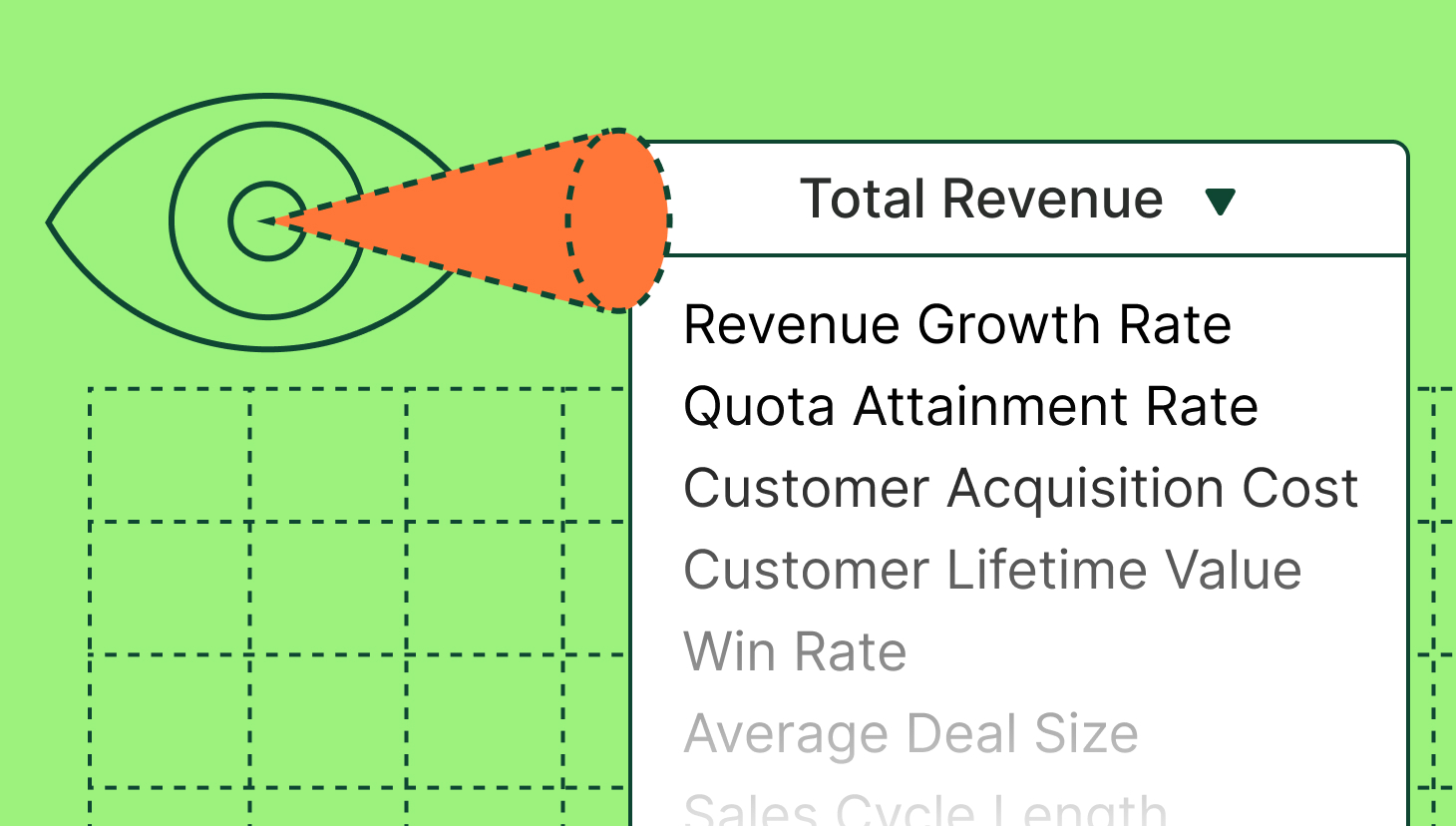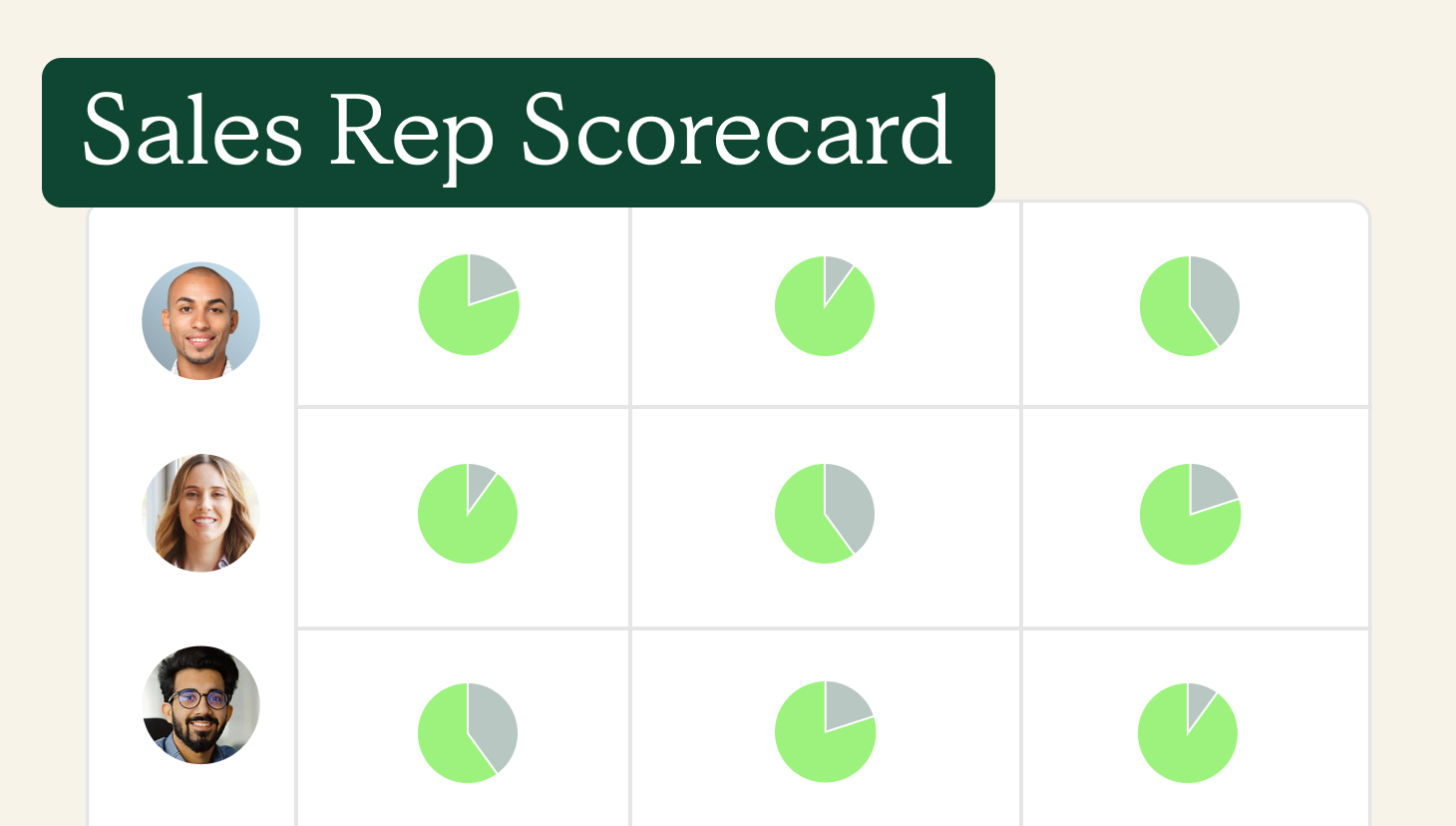Tracking sales performance metrics plays a pivotal role in driving business success.
This process helps you identify strengths and weaknesses to pinpoint areas where sales reps excel and areas needing improvement. Sales productivity metrics help drive business growth by aligning sales strategies with overarching business objectives and monitoring progress toward their attainment.
Monitoring performance criteria for sales enables you to optimize team performance, driving sales team efficiency through tailored training and tools. It also boosts revenue predictability by allowing you to understand sales data patterns to forecast future performance accurately.
In this blog, we discuss sales performance metrics, why and how to track and measure them, highlight the top sales productivity metrics, pitfalls to avoid, and how to select which metrics to track.
It’s a long read, but by the end, you should feel fully prepared to tackle your team’s metrics in the new year.
What Are Sales Performance Metrics?
Sales performance metrics are quantifiable data points that measure the effectiveness of sales activities. These measurements play a key role in assessing individual, team, and organizational sales performance. This data provides insights into key aspects of the sales process, identifying trends and bottlenecks, enabling individual performance evaluation, and compensation strategy development or optimization.
Using Multiple Metrics To Measure Sales Productivity
Above, you’ll notice everything is plural.
“Data points.” “Measurements.” “Metrics.”
That’s because relying on a single sales performance metric has its limitations and can lead to too narrow of a focus, misaligned behaviors, and lack of context.
- Sales reps spend 35% of their time selling. Measuring just revenue fails to account for the time spent on non-revenue-generating activities. Focusing on revenue alone can lead to unhealthy practices like discounting to close deals quickly.
- CSO Insights found that organizations tracking just revenue were more likely to miss potential churn indicators.
Benefits of Comprehensive Approach to Sales Performance Metrics
Meanwhile, a comprehensive approach provides a holistic view of sales productivity while offering additional benefits. A more thorough method improves decision-making, balances team performance, enables early detection of issues, and promotes alignment across teams.
| Benefit | Details |
| Holistic Understanding | By measuring multiple metrics, you get insights into all stages of the sales process: prospecting, closing, and post-sale activities.Example: Using metrics like win rate, average deal size, and pipeline coverage ratio gives a full view of sales health. |
| Improved Decision-Making | Companies that use multiple KPIs to measure sales productivity are 1.5 times more likely to achieve revenue goals.For example, tracking time-to-close alongside conversion rates can reveal inefficiencies in the sales process. |
| Balanced Team Performance | A variety of metrics ensures a balance between short-term results and long-term success. For instance:- Revenue and quota attainment measure short-term success.- Customer satisfaction (CSAT) or Net Promoter Score (NPS) assesses long-term relationship-building. |
| Early Detection of Issues | Multiple metrics help identify bottlenecks before they impact the bottom line. If win rates drop but activity metrics remain high, it signals that lead quality may need improvement. |
| Alignment Across Teams | When RevOps tracks sales productivity using diverse metrics (e.g., CRM adoption, pipeline hygiene, churn rates), it aligns Sales, Marketing, and Customer Success teams around shared goals.Organizations with integrated metrics across teams are 20% more productive. |
Why Analyze Sales Performance?
Tracking performance criteria for sales facilitates sales performance analysis. Analyzing sales performance helps leaders assess the effectiveness of sales strategies and individual and team contributions.
The key benefits of analyzing sales performance include: (BULLETS)
Identify Strengths and Weaknesses: Highlight top-performing reps and areas needing improvement.
Optimize Processes: Discover inefficiencies in the sales funnel such as lengthy deal cycles.
Forecast Accuracy: Improve predictions of revenue and pipeline health.
Drive Strategic Decisions: Inform decisions on territory allocation, resource investment, and training.
Performance analysis acts as a bridge between sales activities and business goal achievement. This process provides valuable insights to hit revenue targets, reduce churn, and align sales with broader company objectives.
Foster a culture of accountability and continuous improvement by leveraging metrics and insights. Start by establishing clear performance indicators, routinely monitoring data, opening sharing insights with employees, and encouraging feedback loops for continuous improvement.
Streamline commissions for your RevOps, Finance, and Sales teams
Design, track, and manage variable incentives with QuotaPath. Give your RevOps, finance, and sales teams transparency into sales compensation.
Talk to SalesCompanywide Sales Metrics
Beyond what’s happening at the team level, you can also look into companywide metrics for high-level view.
Such as:
Total Revenue
Total revenue is the sum of all sales generated across all products and services.
Tracking total revenue is vital because it reflects a company’s overall sales performance and financial health, informing strategic decisions and adjustments for sustained success.
To calculate: Total Revenue = Number of Products Sold x Price Per Product
Revenue Growth Rate
Revenue growth is a company’s sales increase over a specific period.
Tracking total revenue helps leaders understand how well the company converts leads into sales. It’s a key measure of overall business health.
To calculate: Revenue Growth = [(Total Revenue in Current Period – Total Revenue in Previous Period) / Total Revenue in Previous Period] x 100
Quota Attainment Rate
The quota attainment rate is the percentage of a company’s sales reps meeting or exceeding their sales targets.
This metric is crucial for gauging sales performance, identifying coaching needs, and assessing the effectiveness of the compensation plan to motivate sales reps’ performance.
To calculate: Quota Attainment = (Number of reps that achieve sales quota / Total number of reps) x 100
Customer Acquisition Cost (CAC)
Customer acquisition cost is the total cost to secure a new customer.
This measurement helps companies gauge profitability compared to customer lifetime value (CLV) and understand the costs associated with gaining a new customer.
To calculate: (Total cost of sales and marketing)/number of new customers acquired
Customer Lifetime Value (CLV)
Customer lifetime value is a measure of the total revenue a company expects to generate from a customer throughout their relationship with the company.
CLV is an important metric because it can help companies make decisions about resource allocations such as marketing and sales.
To calculate: CLV= Average revenue per year x Average length of time with the company
Win Rate:
The win rate measures how well sales reps close sales by comparing the number of sales opportunities against the number of successfully closed deals, without consideration of the time frame.
Tracking the win rate helps assess the effectiveness of sales strategies and approaches in the current competitive environment to facilitate adjustments and optimization.
To calculate: Win Rate (%) = (Number of won deals/Total number of deals) x 100
Average Deal Size:
The average deal size, also known as the average contract value, is the average value of sales over a given period or for a specific region.
This metric helps companies understand how much revenue is generated from each sale, assess the effectiveness of sales strategies, accurately forecast revenue, and set realistic sales goals.
To calculate: Average Deal Size = Total Revenue/Number of Deals
Sales Cycle Length:
The sales cycle length is the average time it takes for a lead to advance through the sales pipeline from initial contact to deal closure.
Sales cycle length provides insights into sales process efficiency and the identification of bottlenecks. This metric can help organizations lower CAC.
To calculate: Sales Cycle Length = Total Number of Days for All Deals ÷ Total Number of Deals
Pipeline Coverage Ratio
The pipeline coverage ratio is the comparison of the sales opportunities in the pipeline and the sales goals for the period.
This metric helps businesses gauge how healthy their sales pipeline is at a given time and the likelihood of achieving quota. For instance, a pipeline value 3 – 4 times as much as quota for the period is good.
To calculate: Pipeline Coverage = Number of Opportunities in Pipeline in a Period/Quota for That Period
Lead-to-Customer Conversion Rate
The lead-to-customer conversation rate measures the percentage of leads generated by a company that converts into paying customers.
This metric helps assess a company’s sales process effectiveness at transforming potential customers into actual buyers.
To calculate: Lead-to-Customer Conversion Rate = (Number of Converted Customers / Total Number of Leads) x 100%
Customer Retention Rate (CRR)
The customer retention rate measures the number of customers a company retains over a specific period.
It is a business health indicator that helps gauge a company’s ability to retain customers and increase CLV. This metric is also useful for ideal customer profile (ICP) identification and adjustments.
To calculate: CRR = (Total number of customers at the end of a period – Number of new customers acquired during the period) / Total number of customers at the start of the period
Churn Rate
The churn rate highlights the proportion of customers who discontinue product or service use during a given timeframe.
This metric is useful for identifying challenges in areas like sales performance, product fit, and customer service.
To calculate: Churn Rate = ((Number of customers at the start of a period – Number of customers at the end of the period) / (Number of customers at the start of the period)) x 100
Upsell and Cross-Sell Revenue
Upsell and cross-sell revenue are additional revenue generated when customers purchase more expensive versions of products and complementary products.
Tracking this revenue helps the company monitor existing customer growth and ways to boost customer lifetime value while fostering long-term loyalty.
To calculate: Total Upsell and Cross-Sell Revenue = Upsell Revenue + Cross-Sell Revenue
Sales Team Productivity (e.g., revenue per rep)
Sales team productivity measures the average revenue generated by each individual sales rep within a company during a period.
This is a crucial metric for assessing individual and team sales productivity, allowing businesses to identify top performers, pinpoint areas for improvement, and make informed decisions regarding resource allocation and sales strategies.
To calculate: Sales Team Productivity = Total Sales Revenue / The Number of Sales Reps
Forecast Accuracy
A company’s sales forecast accuracy is a measure of how closely projected sales align with actual sales.
This metric measures the reliability of forecasts for a company to make informed decisions about resource allocation, inventory management, strategic planning, optimization of operations, and financial stability.
To calculate: Forecast Accuracy (%) = (1−(Actual Sales−Forecasted Sales)/Actual Sales)×100
Sales Efficiency Ratio (e.g., revenue-to-cost ratio)
A sales efficiency ratio measures how much revenue a company generates for every dollar spent on sales and marketing efforts, gauging how cost-effective their sales process is.
This metric helps identify areas for improvement and measures the ROI of sales efforts.
To calculate: Sales Efficiency Ratio = Total Sales Revenue / Total Sales & Marketing Expenses
Net Promoter Score (NPS)
A Net Promoter Score (NPS) is a customer experience metric that measures how likely a customer is to recommend a company, product, or service to others, based on a single survey question.
NPS helps a company gauge customer loyalty and the potential to retain customers.
To calculate: Net Promoter Score = Percent of Promoters (9-10 rating) – Percent of Detractors (0-6 rating)
Calculate OTE:Quota ratios
Use this free calculator to ensure your reps’ on-target earnings and quotas mirror what they’re bringing in for the business.
Try it NowTeam-Based Sales Metrics
These sales performance metrics examples help with team sales performance analysis.
Team Quota Attainment
The team quota attainment rate is the percentage of a team’s sales reps meeting or exceeding their sales targets.
This metric is crucial for gauging sales performance, identifying coaching needs, and assessing the effectiveness of the compensation plan to motivate sales reps’ performance.
To calculate: Team Quota Attainment = (Number of reps that achieve sales quota / Total number of reps) x 100
Team Win Rate
The team win rate measures how well sales reps close sales by comparing the number of sales opportunities against the number of successfully closed deals, without consideration of time frame.
Tracking the win rate helps assess the effectiveness of sales strategies and approaches in the current competitive environment to facilitate adjustments and optimization.
To calculate: Win Rate (%) = (Number of won deals/Total number of deals) x 100
Team Pipeline Value
Team pipeline value represents the total potential revenue a sales team could generate from all the active sales opportunities currently in the team’s pipeline.
This metric provides insight into the team’s future revenue potential. It allows sales leaders to forecast sales accuracy, identify potential bottlenecks, and make informed decisions about sales strategies to reach targets.
To calculate: Tally the total estimated value of opportunities in the pipeline, using a weighted average based on the likelihood of closing each deal at its current stage.
Sales Activity Metrics
Sales activity metrics are quantifiable measurements used to track and evaluate the day-to-day actions and efforts of a sales team.
This data provides insights into team performance and helps businesses optimize their sales process by identifying areas for improvement. These metrics typically include things like the number of calls made, emails sent, and meetings scheduled.
To calculate: Track the occurrences of these activities within a specific timeframe within your CRM
Average Deal Size
The average deal size, also known as the average contract value, is the average value of sales over a given period or for a specific region.
This metric helps companies understand how much revenue is generated from each sale, assess the effectiveness of sales strategies, accurately forecast revenue, and set realistic sales goals.
To calculate: Average Deal Size = Total Revenue/Number of Deals
Time-to-Close for Team Deals
The time-to-close for team deals measures the average sales cycle length for a sales team from initial contact with a potential customer until a deal is closed.
This metric is a crucial indicator of the sales process and team efficiency in converting leads into paying customers.
To calculate: Time-to-Close for Team Deals = Total number of days for all closed team deals / Total number of closed deals for the period
Forecast Accuracy
A company’s sales forecast accuracy is a measure of how closely projected sales align with actual sales.
This metric measures the reliability of forecasts for a company to make informed decisions about resource allocation, inventory management, strategic planning, optimization of operations, and financial stability.
To calculate: Forecast Accuracy (%) = (1−(Actual Sales−Forecasted Sales)/Actual Sales) × 100
Cross-Selling and Upselling Revenue
Cross-selling and upselling revenue are additional revenue generated when customers purchase more expensive versions of products and complementary products.
Tracking this revenue helps the team monitor existing customer growth and ways to boost customer lifetime value while fostering long-term loyalty.
To calculate: Cross-selling and Upselling Revenue = Cross-Sell Revenue + Upsell Revenue
Pipeline Coverage Ratio
The pipeline coverage ratio is the comparison of the sales opportunities in the pipeline and the sales goals for the period.
This metric helps businesses gauge how healthy their sales pipeline is at a given time and the likelihood of achieving quota. For instance, a pipeline value 3 – 4 times as much as quota for the period is good.
To calculate: Pipeline Coverage = Number of Opportunities in Pipeline in a Period/Quota for That Period

Sales Metrics For Individual Sales Reps
Consider these sales rep performance metrics to understand individual team member performance.
Individual Quota Attainment
Individual quota attainment is the percentage of a sales rep’s sales target they achieve.
This metric is crucial for gauging sales performance, identifying coaching needs, and assessing the effectiveness of the compensation plan to motivate sales reps’ performance.
To calculate: Individual Quota Attainment = (Value of sales achieved / Sales Rep’s Quota) x 100
Win Rate
The win rate measures how well a sales rep closes sales by comparing the number of sales opportunities against the number of successfully closed deals, without consideration of the time frame.
Tracking the win rate helps assess the effectiveness of sales strategies and approaches in the current competitive environment to facilitate adjustments and optimization.
To calculate: Win Rate (%) = (Number of won deals/Total number of deals) x 100
Average Deal Size
The average deal size, also known as the average contract value, is the average value of sales over a given period or for a specific region.
This metric helps companies understand how much revenue is generated from each sale, assess the effectiveness of sales strategies, accurately forecast revenue, and set realistic sales goals.
To calculate: Average Deal Size = Total Revenue/Number of Deals
Sales Cycle Length
The sales cycle length is the average time it takes for a lead to advance through the sales pipeline from initial contact to deal closure.
Sales cycle length provides insights into sales process efficiency and the identification of bottlenecks. This metric can help organizations lower CAC.
To calculate: Sales Cycle Length = Total Number of Days for All Deals ÷ Total Number of Deals
Lead-to-Customer Conversion Rate
The lead-to-customer conversation rate measures the percentage of leads generated by a company that converts into paying customers.
This metric helps assess a company’s sales process effectiveness at transforming potential customers into actual buyers.
To calculate: Lead-to-Customer Conversion Rate = (Number of Converted Customers / Total Number of Leads) x 100%
Revenue Generated
Revenue generated refers to the total amount of income a sales representative brings in by selling a company’s products or services during a specific period.
This metric helps assess individual sales rep performance and their contribution to the company’s total revenue. It is critical for evaluating sales effectiveness and making informed decisions about compensation, training, and sales strategy.
To calculate: Revenue Generated = (Total sales closed by the sales rep during a specific period) x (Average price per sale)
Activity Metrics (e.g., calls, emails, meetings)
Activity metrics are quantifiable measurements used to track and evaluate the day-to-day actions and efforts of a sales rep.
This data provides insights into rep performance and helps businesses optimize their sales process by identifying areas for improvement. These metrics typically include things like the number of calls made, emails sent, and meetings scheduled.
To calculate: Track the occurrences of these activities within a specific timeframe within your CRM
Pipeline Contribution
Pipeline contribution refers to the total value of sales opportunities a specific salesperson currently has within their sales pipeline.
This metric represents a rep’s potential future revenue based on the deals they are actively working on at any given time. It is a key metric for gauging how much a sales rep is contributing to the overall sales goals of the team by tracking the potential revenue tied to their active deals across different stages of the sales process.
To calculate: Pipeline contribution = Total value of deals in sales rep’s pipeline
Upsell and Cross-Sell Revenue
Upsell and cross-sell revenue are additional revenue generated when customers purchase more expensive versions of products and complementary products.
Tracking this revenue helps monitor existing customer growth and ways to boost customer lifetime value while fostering long-term loyalty.
To calculate: Total Upsell and Cross-Sell Revenue = Upsell Revenue + Cross-Sell Revenue
Customer Retention Rate
The customer retention rate measures the number of customers a sales rep retains over a specific period.
This metric provides insight into a rep’s ability to maintain and nurture long-term customer relationships. A high retention rate indicates they know how to keep customers satisfied and loyal, leading to increased lifetime value and sustained revenue for the company.
To calculate: CRR = (Total number of customers at the end of a period – Number of new customers acquired during the period) / Total number of customers at the start of the period
Challenges With Sales Performance Metrics
Sales performance metrics are essential for assessing a sales team’s effectiveness, but they present several challenges.
Data accuracy is a significant issue, as ensuring CRM and reporting tool data are correct and current can be difficult due to human error or delayed entry. Data overload is another concern where the vast number of metrics tracked can divert attention from actionable insights.
Additionally, metric overlap can create redundancy and make it hard to isolate areas needing improvement. Collecting and analyzing these metrics is also time and resource-intensive, diverting resources from other productive activities. Inconsistent definitions can lead to confusion and misalignment of metric definitions across teams. For instance, what qualifies as a “lead” or “activity” can cause reporting discrepancies.
Moreover, the lack of integration between various systems, such as CRM, sales enablement, and marketing platforms, hinders the aggregation of comprehensive insights. It can also be challenging to achieve team alignment where both team-based and individual metrics align with overall company objectives. However, addressing these challenges can lead to a more efficient approach to managing sales performance metrics and better sales outcomes.
How To Choose The Right Sales Metrics For Your Team
Keep these sales performance metrics challenges in mind as you work through the following steps to identify performance criteria for sales in your organization.
| Define Clear Objectives | Align metrics with the specific goals of your team, such as revenue growth, customer retention, or process efficiency. |
| Identify Key Sales Activities | Focus on the activities that directly influence your goals, such as prospecting, closing, or upselling. |
| Evaluate Metric Impact | Select metrics that provide actionable insights and drive behavior that supports your objectives. |
| Ensure Alignment Across Teams | Choose metrics that promote collaboration and consistency with company-wide objectives and other departments. |
| Prioritize Simplicity and Clarity | Limit metrics to those that are easy to track, understand, and act upon to avoid data overload or confusion. |

Tools Used To Measure And Track Sales Performance Metrics
When done manually, tracking and measuring sales productivity metrics can be overwhelming and cumbersome. Leverage tools to streamline the process to facilitate sales performance metrics analysis.
Description: A comprehensive sales compensation and performance management tool that tracks quota attainment, commissions, and team productivity.
Metrics Measured: Quota attainment, earnings forecasts, split deal tracking, and sales rep productivity.
Description: A leading CRM platform with robust reporting and analytics features, enabling sales teams to track pipeline health and performance metrics.
Metrics Measured: Revenue, pipeline value, win rate, sales activity (calls, meetings), and customer retention.
Description: A user-friendly CRM that integrates sales, marketing, and customer service data to provide insights into sales performance.
Metrics Measured: Deal stage progression, lead-to-customer conversion rates, activity metrics, and revenue forecasting.
Description: A revenue intelligence platform that analyzes sales calls and interactions to improve team performance and deal outcomes.
Metrics Measured: Deal win rates, time spent selling, engagement trends, and coaching effectiveness.
Description: A sales engagement platform that automates and tracks communication sequences while providing insights into team activity and effectiveness.
Metrics Measured: Sales activity metrics (emails, calls, meetings), response, and engagement success rates.
Try QuotaPath for free
Try the most collaborative solution to manage, track and payout variable compensation. Calculate commissions and pay your team accurately, and on time.
Start TrialStart Tracking Sales Performance Metrics
Selecting, tracking, and analyzing sales performance metrics is essential to driving business success. Choose multiple sales productivity metrics for a holistic view, improved decision-making, balanced team performance, early issue detection, and team alignment.
This facilitates the identification of strengths and weaknesses, process optimization, improved forecast accuracy, and informed strategic decisions. Start by selecting the sales performance metrics that best suit your needs. Then, streamline the tracking and analysis by leveraging tools.
See how QuotaPath simplifies sales performance metric tracking and analysis. Schedule time with a team member today.



